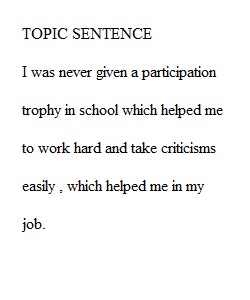


Q • The topic sentence(s) tell(s) the reader what the rest of the paragraph will be about and should include 2 topics: o Topic #1: How you were rewarded in sports or other hobbies as a kid or teen, and how it made you feel at that time. o Topic #2: To what extent your experience supports or refutes one of the participation trophy critiques. (Be sure to identify which critique you’re analyzing.) • The body of the paragraph should include: 2 Claims o One claim about whether you had participation-based or merit-based rewards when you were a kid or teen in sports or other hobbies and how it made you feel (Topic #1) o One claim about the degree to which your experience supports or refutes any of the participation trophy critiques (Topic #2) ? What’s a claim? A claim is (a) sentence(s) the audience can reasonably disagree with that introduce(s) evidence. o You need a minimum of 2 pieces of evidence after each claim ? What’s evidence? Evidence is data, examples, and/or expert opinion that support(s) the claim. Here, the evidence is likely to come from your experience, so examples. E.g. One example of how my student identity was affected by the negative stereotype that women/girls are not good at math is that I developed moderate levels of math phobia starting in Junior High. I would get really nervous before Algebra class, and I had trouble focusing during exams because I was worried about doing poorly. o Sufficient explanation to make the claims and supporting evidence persuasive ? What’s explanation? Explanation provides any necessary context for understanding how the claims and evidence work together to create a persuasive argument. o Links/Transitions between one sentence and the next (and one idea and the next) o Concluding sentence(s) About the conclusion: o The conclusion is not a separate paragraph. It is a few sentences at the end of your second paragraph. o Use the conclusion to go beyond your personal experience and connect with your audience about the paragraph topic. o Here are some questions for you to consider, but what you choose to cover in the conclusion is up to you. ? Is there a place for participation-based rewards for kids? For adults? If so, in what context(s) and why? ? Should adults (whether or not they are parents) be concerned about the participation trophy trend? If so, what should they do about it? If not, why not? ? Are you concerned about the financial incentives of the trophy and prize industry influencing kids’ sports? If so, what do you think should be done? o Do not simply repeat or re-state your topic sentence position. The paper is quite short, so the reader will still remember what your topic sentence position was at the end of the paragraph. Please do not simply repeat that same idea in the conclusion.
View Related Questions